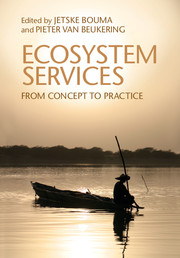Book contents
- Frontmatter
- Contents
- About the authors
- Part I Introduction
- Part II Measuring ecosystem services
- Part III Valuing ecosystem services
- 5 Economic values of ecosystem services
- 6 Economic valuation methods for ecosystem services
- 7 Trade-offs and decision-support tools for managing ecosystem services
- Part IV Paying for ecosystem services
- Part V Governing ecosystem services
- Index
- Plate section
- References
6 - Economic valuation methods for ecosystem services
from Part III - Valuing ecosystem services
Published online by Cambridge University Press: 05 February 2015
- Frontmatter
- Contents
- About the authors
- Part I Introduction
- Part II Measuring ecosystem services
- Part III Valuing ecosystem services
- 5 Economic values of ecosystem services
- 6 Economic valuation methods for ecosystem services
- 7 Trade-offs and decision-support tools for managing ecosystem services
- Part IV Paying for ecosystem services
- Part V Governing ecosystem services
- Index
- Plate section
- References
Summary
Introduction
Various valuation methods exist and have been applied to estimate the values of different ecosystem services. The methods reflect the extent to which the services provided by ecosystems touch on the welfare of society either as direct determinants of individuals’ well-being (e.g. as consumer goods) or via production processes (e.g. as intermediate goods). The aim of this chapter is to provide an overview of available valuation methods, to discuss their advantages and disadvantages, and to provide guidance on when to use which method. In doing so we do not aim to be comprehensive; extensive details of the underlying theory and on the actual practice of applying the valuation methods are provided in general texts, including Braden and Kolstad (1991), Freeman (2003), Bateman et al. (2002), Mitchell and Carson (1989), Champ et al. (2003), Bockstael and McConnell (2007), and Kanninen (2007).
A number of economic valuation methods have been developed to estimate the value of changes in ecosystem services. An important distinction is between market-based and non-market-based valuation methods. Market-based valuation means that existing market behavior and market transactions are used as the basis for the valuation exercise. Economic values are derived from actual market prices for ecosystem services, both when they are used as inputs in production processes (production values) and when they provide direct outputs (consumption values). By observing how much of an ecosystem service is bought and sold at different prices, it is possible to infer directly how people value that good. Examples of market-based methods are the use of direct market prices, net factor income and production function methods, and the calculation of replacement costs, defensive expenditures, and avoided damage costs.
- Type
- Chapter
- Information
- Ecosystem ServicesFrom Concept to Practice, pp. 108 - 131Publisher: Cambridge University PressPrint publication year: 2015
References
- 11
- Cited by



